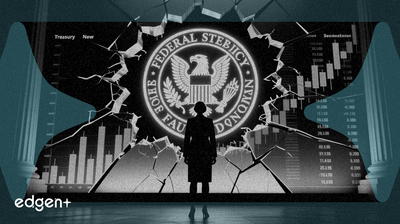Related News

US Consumer Confidence Declines Sharply in November Amid Rising Inflation and Recession Concerns
## The Event in Detail The Conference Board reported a significant downturn in U.S. consumer sentiment for November 2025, with the **Consumer Confidence Index**® falling by 6.8 points to 88.7 from a revised 95.5 in October. This marks the fourth consecutive monthly decline. A key component of the index, the **Expectations Index**, which reflects consumers' short-term outlook for income, business, and labor market conditions, saw a more pronounced drop of 8.6 points, falling to 63.2. This suggests growing pessimism about the economic landscape over the next six months. ## Market Implications The sharp decline in consumer confidence, particularly in future expectations, signals a potential pullback in consumer spending, a primary driver of the U.S. economy. The survey data indicates that consumers have already begun to curb planned spending on services over the next six months. This reticence could dampen economic growth and increase the probability of a recession. Furthermore, consumers' views on their family's current and future financial situations faltered, reinforcing the likelihood of more cautious household spending behavior heading into the new year. ## Expert Commentary According to **Dana M. Peterson, Chief Economist at The Conference Board**, the November figures represent a notable deterioration after a period of relative stability. Peterson stated: > "Consumer confidence tumbled in November to its second lowest level since April after moving sideways for several months." This commentary underscores the severity of the drop and suggests that underlying economic anxieties are intensifying among the American public. ## Broader Context The erosion of confidence is occurring within a context of persistent inflationary pressures and a shifting labor market outlook. The survey revealed that consumers' average **12-month inflation expectations** remained elevated, with the median rate rising to 4.8%. This sustained concern about the rising cost of living is a key factor weighing on sentiment. Concurrently, while expectations for job losses saw a slight improvement, the overall outlook for labor market conditions in mid-2026 remained decidedly negative, and expectations for future household income growth have diminished.

Treasury Secretary Bessent Signals Pre-Christmas Federal Reserve Chair Nomination, Advocates for Policy Overhaul
## Executive Summary Statements from U.S. Treasury Secretary Scott Bessent regarding a potential pre-Christmas nomination for the next Federal Reserve Chair have introduced significant uncertainty into the future of American monetary policy. Bessent, who is reportedly on the shortlist for the position, simultaneously outlined a vision for a reformed Federal Reserve with a reduced, "behind-the-scenes" role. This development signals a potential major pivot in the central bank's structure and operational independence, with profound implications for financial markets. ## The Event in Detail On Tuesday, Treasury Secretary Scott Bessent announced that he expects President Donald Trump to name a successor to Federal Reserve Chair Jerome Powell, whose term expires in May 2026, before the Christmas holiday. This accelerated timeline puts a spotlight on the administration's intentions for the central bank. Compounding the situation, President Trump confirmed that Secretary Bessent is one of four candidates on his personal shortlist for the top role at the Fed. Bessent has been a vocal critic of the Fed's current operational framework, calling for a "fundamental reset" of its policies. ## Market Implications The potential appointment of a new Chair, particularly one with Bessent's stated reformist agenda, could dramatically reshape U.S. monetary strategy. His calls to simplify the Fed's policy toolkit could signal a move away from instruments like quantitative easing. Furthermore, his proposal to strip the Fed of its bank supervision duties and leave them to other government authorities would represent a significant restructuring of financial regulation in the United States. The most critical implication for markets is the potential erosion of the Federal Reserve's political independence. The appointment of a sitting Treasury Secretary, who has publicly advocated for specific policy changes, could be perceived as an attempt to align monetary policy with short-term political objectives. This could undermine the central bank's credibility in managing inflation and maintaining long-term economic stability, potentially leading to increased market volatility. ## Expert Commentary Secretary Bessent has been clear about his desire for policy changes at the central bank. His public statements outline a specific critique of the Fed's current approach: > "The Fed must change course. Its standard tool kit has become too complex to manage, with uncertain theoretical underpinnings." He has also directly addressed the Fed's market interventions, specifically its bond-buying programs, stating the institution should: > "...scale back the distortions it causes in the economy, including by bond purchases made outside of true crisis conditions." ## Broader Context The independence of the Federal Reserve has long been a cornerstone of the U.S. financial system, designed to insulate monetary policy from short-term political pressures. This separation is widely seen as crucial for the effective control of inflation and the promotion of sustainable economic growth. The nomination of a Treasury Secretary to the role of Fed Chair, especially one with a public mandate to overhaul the institution, would challenge this long-standing norm. Such a move would intensify the ongoing debate about the appropriate level of executive influence over the central bank and could set a new precedent for the relationship between the Treasury Department and the Federal Reserve.

Orica Limited Increases Dividend to A$0.32, Yielding 2.4% Amid Sustainability Questions
## Executive Summary **Orica Limited** (ASX:ORI) has declared an increased dividend of A$0.32 per share, an increase from the corresponding period last year. This results in a dividend yield of 2.4%, offering a minor uplift in shareholder returns. However, the positive short-term news is tempered by underlying questions regarding the long-term sustainability of the company's dividend policy, stemming from its payout ratio and historical volatility in payments. ## The Dividend Announcement in Detail Orica Limited confirmed that its upcoming dividend payment will be A$0.32 per share, scheduled for distribution on the 22nd of December. This payment marks an increase compared to the dividend issued during the same period in the previous year. The calculated dividend yield based on the current stock price stands at 2.4%, a figure that provides a direct, albeit modest, return to investors. ## Market Implications and Shareholder Returns The 2.4% dividend yield is characterized as a "modest boost" for shareholder returns. For income-oriented investors, the increase represents a tangible, positive development. However, the modest scale of the yield is unlikely to be a significant catalyst for attracting new investors who are primarily focused on high-yield opportunities. The market reaction is expected to be neutral to slightly positive, reflecting the balance between the increased payout and the underlying financial metrics. ## Analysis of Financial Health and Sustainability While an increased dividend is typically viewed favorably, a deeper analysis raises concerns about its sustainability. The decision comes amidst scrutiny of **Orica's** payout ratio, which measures the proportion of earnings paid out as dividends. A high payout ratio can indicate that a company is returning a large portion of its earnings to shareholders, but it may also suggest a limited capacity for reinvestment or a potential strain on finances. Furthermore, the company has a track record of instability in its dividend payments, which may cause investors to question the reliability of this increased payout in the long term. ## Broader Context In the current market, a dividend yield of 2.4% is not exceptional and is consistent with returns offered by other established companies. This context suggests that **Orica's** dividend increase is more of a conservative adjustment than a significant strategic shift in its capital return policy. The focus for sophisticated investors will likely remain on the company's core earnings power and its ability to maintain and grow dividends in a sustainable manner, rather than on the immediate, modest gain from this specific payment.
